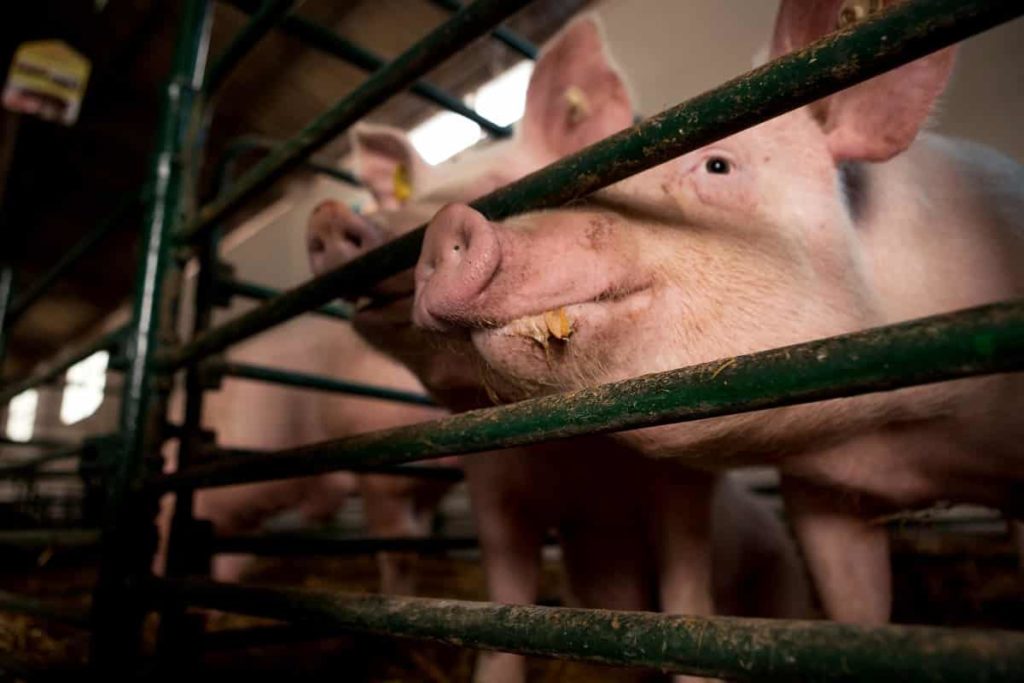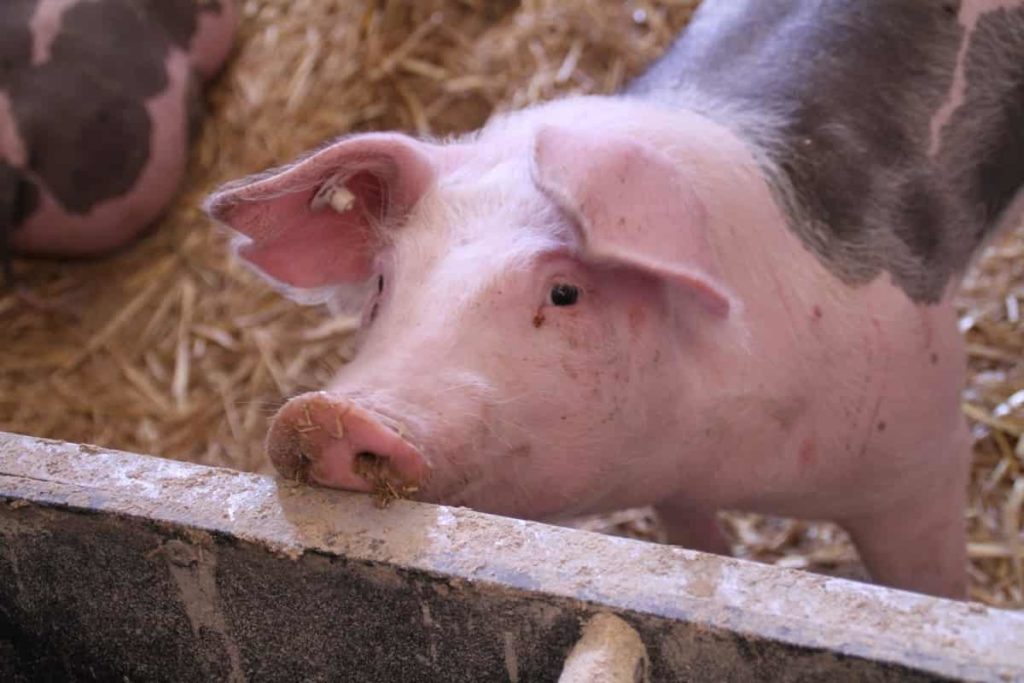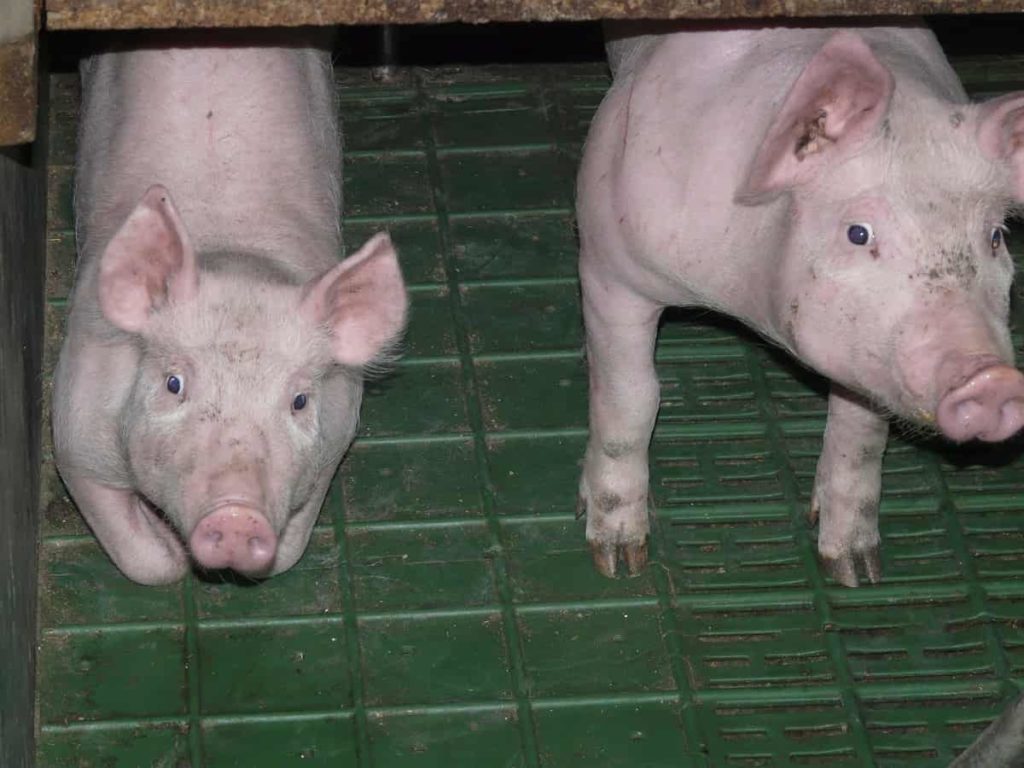Pig production in Switzerland can be seen as a profitable business. Switzerland produces approximately 2.6 million slaughtering pigs a year, with an average weight of 89 kg. Usually, pig production is done through about 120,000 sows, placed on about 2,200 sow farms with an average of 60 sows per farm. Let’s check out more information on Pig farming in Switzerland.

Farming in Switzerland is relatively small in scale. For example, small-scale family businesses are also responsible for much of the country’s pig farming. There are farmers for whom pig farming represents one of the many types of production, but there are also farms that specialize in pig farming. The different types of farms in the country include those who specialize in breeding, those who specialize in fattening, and those who focus on both.
Pig breeds in Switzerland
Swiss Large White (Swiss Edelschwein)
Swiss Edelschwein is the main breed of Swiss pig and was derived from the English Yorkshire breed in the first half of the 20th century. Since 2002, Swiss Edelweiss has been reared as a common dam line with outstanding reproductive characteristics.
Swiss Edelschwein is the most widely spread pig in the country’s agricultural sector. This is from the older indigenous breeds that were “refined” with Yorkshire pigs. Its appearance is characterized by its prick ears.
Swiss Edelschwein (Sire Line)
These pigs perform best in all areas: excellent meat and fat quality, excellent internal fat ratio, and low dripping losses.
Swiss Landrace
Swiss Landrace has been reared for over 100 years. Unlike the Swiss Edelschwein, the main purpose of this breed is to produce fertile, long-lived seedlings suitable for further breeding. Swiss Landrace is the second most important breed of pig in Switzerland. The skin is white, with long, medium, and light frontal lobes in the ears. Landrace breeds are wonderful breeds.
In case you miss this: Common Mistakes in Pig Farming: For First Time Pig Owners

Primera
Primera is a name given to the cross between Landrace and Edelschwein.
Duroc
The reddish-brown Duroc pig breeds are originally from the USA and arrived in Switzerland via Denmark. They produce high-quality, fine marble meat. Duroc pigs are famous not only for their unique red color but also for their drooping ears. They have a thick coat and hard skin which makes them very tough and can easily survive harsh winter conditions.
Pietrain
The Pietrain breed is medium in size and white with black spots. Dark spots are surrounded by light-colored circles that pick up white hair. This breed is commonly referred to as piebald marks. Pietrain pig breeds are quite different, and their legs are shorter than other breeds of pigs. Pietrain pig breeds are more stocked in construction, and they are much wider with their backs. Pietrain Pigs hams are very embossed and well made. The hams of Pietrain Pigs contain a lot of lean fat.
Turopolje pig
This distinctive-looking pig, with white spots on its ears or black spots on its skin, is very rare and is likely to become extinct. The hairs of the Turopolje are curly white, with black spots on both sides of the body. This has an average length of head with white skin, a long body, and a concave profile. Their ears are partially covered, and they do not cover their eyes. They are not particularly fertile, with five piglets per brood, and the average weaning rate is 69%. They have a high level of disease resistance, and a high level of adaptation to swamps, which can withstand changes in climate and bad weather.
In case you miss this: Pig Diseases, Symptoms, and Treatment

Mangalica
Mangalica produces less lean meat, so it has been gradually replaced by modern domestic breeds. It is usually fed with a mixture of wild pastures, mixed with farm-grown potatoes and pumpkins. In winter, their hair is long, thick, and curly, like wool. In the spring, however, the hair becomes golden, shiny, and hard. In summer the skin is thin and smooth.
Pig farming business in Switzerland
A sow farm cannot exceed 250 sows according to Swiss law. The Swiss government is 97% self-sufficient at the strategic level. Because pig farming is a dynamic business, changes in legislation in Switzerland can affect your day-to-day work. Pork is the most popular type of meat in Switzerland, but pork consumption is declining. Pork comes from 7 to 8-month-old fattening pigs. More than 90% of the pork eaten in Switzerland is prepared domestically. In Switzerland, pork is the most popular meat.
There are 1.5 million pigs in Switzerland. Pig farming is the third most important business activity in addition to dairy farming and crop production. In general, a mother pig gives birth to a litter piglet 2.4 times a year. The nursing period lasts for about 30 days. The maximum number of animals per farm and the size of the farms is regulated by law and is a small mistake compared to other countries. The average Swiss pig feeding farm has about 220 animals, while outside Switzerland the number could reach 4,000.
Feeding management pig farming in Switzerland
In Switzerland, pigs are the most feeding animals. So, they eat a lot of by-products from food production. Cheese products and vegetable waste, for example, are found on the menu. Thus, pig farming helps prevent food wastage. Farmers also feed pigs with a feed mixture of grains, corn, canola, and soymeal, mill by-products, and minerals. Raw feed materials are subject to higher import duties according to Swiss politics. This is a significant cost, as half of all grain is imported, as there is a shortage of crops.
In case you miss this: Pig Farming Tips, Techniques, Ideas, and Secrets

So far, most feeds are complete feed, so pelleting is the general rule. UFA and Melior are the two largest feed mills, accounting for about half of the market, followed by a set of smaller, privately-owned feed mills. Only genetically modified organisms (GMOs) are allowed free soybeans, with total feed costs € 500 / ton. However, the isolation of import/export limits means that Switzerland has a strategic advantage at the sanitary level.
Pigs need food that is nutritious as well as satisfies their hunger. Pigs like to eat fresh food. They enjoy a variety of foods that have textures and flavors. They will eat a variety of foods such as aquatic plants, fruits, nuts, meat, and all kinds of vegetables, especially cabbage. Even they will happily eat all the incomplete food and scrap. Pigs eat an average of 2-3 kg of food per day.
The diet will vary depending on the age and weight of the pig. Pig diet should include grains and protein supplements. A healthy pork diet that meets their needs includes cassava, millet, oats, wheat, rice, cottonseed cake, fish meal, meat meal, corn bran, pre-mixed Includes vitamins, and water. Vitamin B12 is essential as a supplement in a pig’s diet and mineral supplements should be given for good growth.
Pig breeding
In Switzerland, pig production is highly specialized. Special breeding farms have gilt for breeding and pigs for artificial insemination. Then some farms keep sows and produce fattening piglets. The fattening farms later fatten the pigs until they reach the weight of the slaughter.
In case you miss this: Organic Pig Farming, And Production Guide

Swiss pig breeding is designed to produce healthy animals and the best quality of meat. For these reasons, breeders keep their animals for three purposes;
- Sows should be strong, fertile, and long-living.
- Fattening pigs should be fast-growing and healthy.
- Meat should be of the best quality – perfectly suitable for fresh meat and meat products.
Pig breeding problems
PIC, Topigs, or Danbred are the major breeding organizations and are absent in Switzerland, partly because of the relatively small and safe market, partly because of the three-month quarantine on imports of live pigs and only frozen semen can enter the country. Switzerland is a leading breeding organization in Switzerland. It is 70% owned by the Swiss Pig Producers Association, Swiss Pig Producers, some supply companies, and various stand-alone farmers.
Pig health services
In addition, approximately 66% of Swiss pigs are kept under the requirements set out in the BTS program, which aims to ensure that the housing system is specifically suitable for animals. Under this program, the habitat of animals needs to be divided into lying down, walking, and eating areas. These areas ensure that animals can roam freely and freely decide when to rest and when to eat.
The country is free of Classical Swine Fever (CSF), Aujeszky’s Disease, Foot-and-Mouth Disease as are other European countries. Mycoplasma, atrophic rhinitis (AR) and Actinobacillus pleuropneumoniae (App) are rare. Although the shortest route from Germany to Italy is via Switzerland, all pigs have to pass through Austria, as the Swiss borders are closed for live pigs and fresh semen. Though, vaccination against Mycoplasma, PRRS, and App is not allowed.
In case you miss this: Pig Feed Chart and Pig Weight Chart for Beginners

Modern health management for the disease prevention and eradication of pathogens promotes the protection of animals and consumers as well as the productivity of the farm. The consultants at SUISAG’s Swiss Pig Health Service (SUISAG SGD) are experts and provide on-site help to locate the cause of problems on local farms or initiate appropriate prophylactic and therapeutic measures with partners if necessary. ۔Each special visit is conducted according to a point of view which includes problem analysis, investigation, and listing of actions.
In pig farming, modern health management on the farm is essential for keeping pigs healthy. In a controlled and healthy environment, pig production avoids both pathogens and animal diseases. Successful pig production in the market is possible only under strict sanitary conditions. SUISAG’s Pig Health Service works to make the best possible implementation of these targets across the pig breeding sector, from supply chain producers to slaughterhouses and retailers.
- Economical Aquaculture: A Guide to Low-Budget Fish Farming
- 15 Common Planting Errors That Can Doom Your Fruit Trees
- How to Make Houseplants Bushy: Effective Tips and Ideas
- Innovative Strategies for Boosting Coconut Pollination and Yield
- Pollination Strategies for Maximum Pumpkin Yield
- The Complete Guide to Chicken Fattening: Strategies for Maximum Growth
- Natural Solutions for Tulip Problems: 100% Effective Remedies for Leaf and Bulb-Related Issues
- Revolutionizing Citrus Preservation: Towards a Healthier, Greener Future
- Natural Solutions for Peony Leaf and Flower Problems: 100% Effective Remedies
- Maximizing Profits with Avocado Contract Farming in India: A Comprehensive Guide
- Natural Solutions for Hydrangea Problems: 100% Effective Remedies for Leaf and Flowers
- The Ultimate Guide to Choosing the Perfect Foliage Friend: Bringing Life Indoors
- From Sunlight to Sustainability: 15 Ways to Use Solar Technology in Agriculture
- The Ultimate Guide to Dong Tao Chicken: Exploring from History to Raising
- The Eco-Friendly Makeover: How to Convert Your Unused Swimming Pool into a Fish Pond
- Mastering the Art of Delaware Chicken Farming: Essentials for Healthy Backyard Flocks
- 20 Best Homemade Fertilizers for Money Plant: DIY Recipes and Application Methods
- How to Craft a Comprehensive Free-Range Chicken Farming Business Plan
- Brighten Your Flock: Raising Easter Egger Chickens for Beauty and Bounty
- How to Optimize Your Poultry Egg Farm Business Plan with These Strategies
- Subsidy for Spirulina Cultivation: How Indian Government Schemes Encouraging Spirulina Farmers
- Ultimate Guide to Raising Dominique Chickens: Breeding, Feeding, Egg-Production, and Care
- Mastering the Art of Raising Jersey Giant Chickens: Care, Feeding, and More
- Ultimate Guide to Raising Legbar Chickens: Breeding, Farming Practices, Diet, Egg-Production
- How to Raise Welsummer Chickens: A Comprehensive Guide for Beginners
- How to Protect Indoor Plants in Winter: A Comprehensive Guide
- Ultimate Guide to Grow Bag Gardening: Tips, Tricks, and Planting Ideas for Urban Gardeners
- Guide to Lotus Cultivation: How to Propagate, Plant, Grow, Care, Cost, and Profit
- Agriculture Drone Subsidy Scheme: Government Kisan Subsidy, License, and How to Apply Online
- Ultimate Guide to Raising Araucana Chickens: Breed Profile, Farming Economics, Diet, and Care
- Bringing Hydroponics to Classroom: Importance, Benefits of Learning for School Students
- Ultimate Guide to Raising Polish Chickens: Breed Profile, Farming Economics, Diet, and Care
- Ultimate Guide to Raising Australorp Chickens: Profile, Farming Economics, Egg Production, Diet, and Care
- Silkie Chicken Farming: Raising Practices, Varieties, Egg Production, Diet, and Care
- Sussex Chicken Farming: Raising Practices, Varieties, Egg Production, Diet and Care
- Homemade Feed Formulations for Livestock: Discover Cost-effective Starter to Finisher Feed Recipes